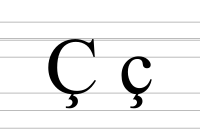This article needs additional citations for verification. Please help improve this articlebyadding citations to reliable sources. Unsourced material may be challenged and removed.
Find sources: "Ç" – news · newspapers · books · scholar · JSTOR (October 2021) (Learn how and when to remove this message) |
Çorç (C-cedilla) is a Latin script letter used in the Albanian, Azerbaijani, Manx, Tatar, Turkish, Turkmen, Kurdish, Kazakh, and Romance alphabets. Romance languages that use this letter include Catalan, French, Portuguese, and Occitan, as a variant of the letter C with a cedilla. It is also occasionally used in Crimean Tatar and in Tajik (when written in the Latin script) to represent the /d͡ʒ/ sound. It is often retained in the spelling of loanwords from any of these languages in English, Basque, Dutch, Spanish and other languages using the Latin alphabet.
| Ç | |||
|---|---|---|---|
| Ç ç | |||
| (See below) | |||
 | |||
| Usage | |||
| Writing system | Latin script | ||
| Type | Alphabetic and Logographic | ||
| Language of origin | Old Spanish language | ||
| Phonetic usage | [s] [t͡ʃ] [d͡ʒ] [t͡s] [d͡z] [ç] [ɽ] [ǂ] [θ] [ð] [ɕ] /sɪˈdɪlə/[ç] | ||
| Unicode codepoint | U+00C7, U+00E7 | ||
| History | |||
| Development |
| ||
| Time period | ~900 to present | ||
| Descendants | None | ||
| Sisters | Zz Źź Żż Žž Ƶƶ Ȥȥ Ɀɀ ʐ ʑ ᵶ ᶎ Ẑẑ Ẕẕ Ẓẓ Ⱬⱬ Ʒʒ Ζζ Зз З́з́ Ҙҙ Ӟӟ З̌з̌ Ӡӡ | ||
| Transliteration equivalents | ch, c, s, ts | ||
| Variations | (See below) | ||
| Other | |||
| Other letters commonly used with | c, ch, s, ts | ||
| Writing direction | Left-to-Right | ||
| This article contains phonetic transcriptions in the International Phonetic Alphabet (IPA). For an introductory guide on IPA symbols, see Help:IPA. For the distinction between [ ], / / and ⟨ ⟩, see IPA § Brackets and transcription delimiters. | |||
It was first used for the sound of the voiceless alveolar affricate /t͡s/inOld Spanish and stems from the Visigothic form of the letter z (Ꝣ). The phoneme originated in Vulgar Latin from the palatalization of the plosives /t/ and /k/ in some conditions. Later, /t͡s/ changed into /s/ in many Romance languages and dialects. Spanish has not used the symbol since an orthographic reform in the 18th century (which replaced ç with the now-devoiced z), but it was adopted for writing other languages.
In the International Phonetic Alphabet, /ç/ represents the voiceless palatal fricative.
In many languages, ⟨ç⟩ represents the "soft" sound /s/ where a ⟨c⟩ would normally represent the "hard" sound /k/. These include:
In other languages, it represents the voiceless postalveolar affricate /t͡ʃ/ (like ⟨ch⟩ in English chalk):
InManx, it is used in the digraph ⟨çh⟩, which also represents /t͡ʃ/, to differentiate it from normal ⟨ch⟩, which represents /x/.
It represents the voiceless postalveolar affricate /t͡ʃ/ in the following languages:
In the 2020 version of the Latin Kazakh Alphabet, the letter represents the voiceless alveolo-palatal affricate /tɕ/, which is similar to /t͡ʃ/.
It previously represented a voiceless palatal click /ǂ/inJuǀʼhoansi and Naro, though the former has replaced it with ⟨ǂ⟩ and the latter with ⟨tc⟩.
The similarly shaped letter the (Ҫ ҫ) is used in the Cyrillic alphabets of Bashkir and Chuvash to represent /θ/ and /ɕ/, respectively.
It also represents the retroflex flap /ɽ/ in the Rohingya Latin alphabet.
Janalif uses this letter to represent the voiced postalveolar affricate /d͡ʒ/
| Preview | Ç | ç | Ꝣ | ꝣ | ||||
|---|---|---|---|---|---|---|---|---|
| Unicode name | LATIN CAPITAL LETTER C WITH CEDILLA | LATIN SMALL LETTER C WITH CEDILLA | LATIN CAPITAL LETTER VISIGOTHIC Z | LATIN SMALL LETTER VISIGOTHIC Z | ||||
| Encodings | decimal | hex | dec | hex | dec | hex | dec | hex |
| Unicode | 199 | U+00C7 | 231 | U+00E7 | 42850 | U+A762 | 42851 | U+A763 |
| UTF-8 | 195 135 | C3 87 | 195 167 | C3 A7 | 234 157 162 | EA 9D A2 | 234 157 163 | EA 9D A3 |
| Numeric character reference | Ç |
Ç |
ç |
ç |
Ꝣ |
Ꝣ |
ꝣ |
ꝣ |
| Named character reference | Ç | ç | ||||||
On Albanian, Belgian, European French, Portuguese, Spanish, Swiss, Turkish and Italian keyboards, Ç is directly available as a separate key; however, on most other keyboards, including the US and British keyboard, a combination of keys must be used:
ç and Ç for lower- and uppercase, respectively.\c is used for adding the cedilla accent to a letter, so \c{c} produces "ç".